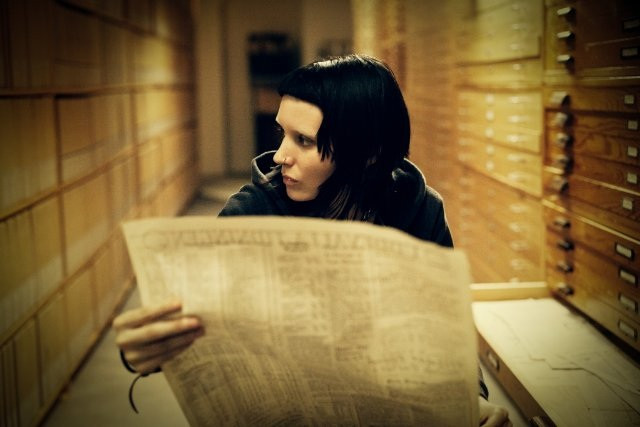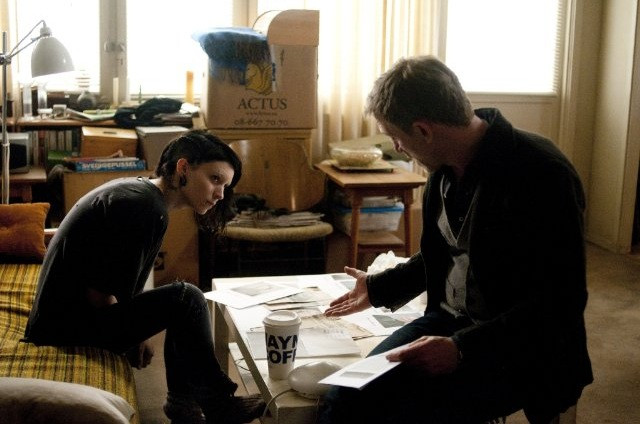Lisbeth Salander. The name itself conjures images of rebellion, intellect, and a fiercely independent spirit. For fans of Stieg Larsson’s Millennium Trilogy, Lisbeth is more than a character; she’s an icon. As a content creator for tattooat.com, delving into the visual and symbolic aspects of characters is always fascinating, and Lisbeth Salander, with her striking dragon tattoo, is a prime example. Having followed the journey of this punk hacker through books and films, I, like many, approached the Hollywood remake of The Girl With the Dragon Tattoo with a mix of anticipation and trepidation.
Initial marketing for the American adaptation seemed to misrepresent the core of Lisbeth, hinting at a damsel in distress narrative that felt jarringly off-key. The fear was that Hollywood would dilute the very essence of this unique and powerful female protagonist. However, upon watching David Fincher’s rendition, a pleasant surprise emerged, anchored by Rooney Mara’s transformative performance.
For those unfamiliar, The Girl With the Dragon Tattoo kicks off The Millennium Trilogy, intertwining the lives of Mikael Blomkvist (Daniel Craig), a journalist in disgrace, and Lisbeth Salander (Rooney Mara), a brilliant and enigmatic researcher. Together, they embark on a dark and intricate investigation into the disappearance of a woman forty years prior. The narrative is a compelling blend of suspenseful mystery and sharp social commentary, addressing themes of violence against women, sexuality, and restrictive gender roles.
The question of necessity often arises with remakes. Yet, Fincher, known for his meticulous approach, crafted a visually stunning film, steeped in a macabre atmosphere, amplified by Trent Reznor’s haunting score. The cast is stellar – Craig, Robin Wright, Christopher Plummer, Stellan Skarsgaard, Vanessa Redgrave – each delivering strong performances. While the remake might not surpass the original Swedish films in overall impact, Mara’s portrayal of Lisbeth Salander stands out as the definitive reason to watch.
Lisbeth Salander is a career-defining role. Both Noomi Rapace, who originated the role in the Swedish films, and Rooney Mara underwent intense preparation. This included physical transformations like haircuts, multiple piercings, and embracing nudity, alongside rigorous training in kickboxing, skateboarding, and motorcycle riding. Lisbeth is portrayed as a withdrawn introvert, yet possesses immense inner strength and self-reliance. She’s characterized by her sharp intellect and unwavering survival instincts, a product of enduring significant trauma, yet resolutely refusing victimhood.
 Rooney Mara as Lisbeth Salander in The Girl with the Dragon Tattoo, showcasing her intense gaze and the character's rebellious spirit.
Rooney Mara as Lisbeth Salander in The Girl with the Dragon Tattoo, showcasing her intense gaze and the character's rebellious spirit.
Fincher’s unwavering insistence on casting Mara, despite initial studio hesitation, proved to be a masterstroke. Analyzing Mara’s performance, it’s not about grand gestures but subtle nuances that make her portrayal so captivating. As Melissa Silverstein noted, Mara completely “disappears into the role.” Small details, like Lisbeth’s almost frantic “Hey, hey” when greeting those she trusts, Holger Palmgren and Mikael, add layers to her character. It’s in the clipped cadence of her voice, her subtly slumped posture, the vulnerability in her eyes. Mara doesn’t just act as Lisbeth; she embodies her.
The discussion often circles back to comparing Mara’s Lisbeth with Noomi Rapace’s acclaimed interpretation. Many ponder whether to favor Rapace’s fiercely independent warrior, closer to the initial book depiction, or Mara’s more vulnerable yet quietly powerful portrayal. Having seen both, it becomes clear that neither performance overshadows the other. They are distinct yet equally compelling, offering different facets of Lisbeth’s complex personality – two sides of the same coin. Mara, stepping into the considerable shoes left by Rapace, delivers a performance that is not just captivating but also uniquely her own. Overlooking it due to initial marketing missteps would mean missing one of the most remarkable performances of that year.
 Lisbeth Salander looking intensely focused, highlighting the character's intellectual prowess and determination.
Lisbeth Salander looking intensely focused, highlighting the character's intellectual prowess and determination.
The graphic depiction of rape in The Girl With the Dragon Tattoo has sparked both praise and condemnation. The American version doesn’t shy away from the brutal reality of these scenes. Living in a culture where sexual violence is often minimized or even glorified, Larsson’s work, originally titled Män Som Hatar Kvinnor (“Men Who Hate Women”), confronts the pervasive issue of misogyny head-on. The book, the Swedish films, and Fincher’s remake, all tackle the stigma of sexual assault without sensationalizing it. Lisbeth, crucially, is never portrayed as a victim. She operates by her own moral code, dispensing vigilante justice. Lacking traditional power structures, she navigates the patriarchal system to assert control over her own life and destiny.
The core of the narrative, spanning the entire trilogy, is the evolving friendship between Lisbeth and Mikael. Despite their contrasting social behaviors – Mikael being outwardly social, Lisbeth intensely private – they share an unwavering moral compass. Mikael is consistently intrigued and often amused by Lisbeth’s unconventional perspectives and reactions. His openness and honesty foster a rare trust in Lisbeth. While the film acknowledges their sexual relationship, it perhaps underplays the depth of their emotional bond. Both characters exhibit a distinct sexuality. Lisbeth’s sexual fluidity, her relationships with both men and women, contrasts sharply with the societal acceptance of Mikael’s philandering, highlighting a crucial commentary on gender and sexual double standards, though somewhat muted in the film adaptation.
However, a critical point of contention in Hollywood’s The Girl With Dragon Tattoo emerges in a single, seemingly small line of dialogue. Spoiler Alert! In the scene where Mikael is rescued from the noose, Lisbeth, poised to pursue his attacker, asks, “May I kill him?”
In an interview with Charlie Rose, Fincher discussed what he found compelling about Lisbeth, notably stating that he doesn’t see her as a feminist figure, arguing that the story isn’t inherently feminist:
“I think that she is many things to many different people…I was fascinated by the fact that 60-year-old men, you know 58-year-old women, 17-year-old girls were all finding something about her that was you know freeing or empowering in some kind of way. And it had been kind of sold to me as this you know misogynist avenger. But what I felt about it was ultimately that there wasn’t any kind of real feminist tract to it all.
“To me, it was very human. It’s a story of being oppressed, a story of being marginalized, a story of being made to feel less than, it’s a character that’s been made to feel less than who she thinks she is…”
This perspective seems to fundamentally misunderstand the essence of feminism. A feminist narrative is inherently a human narrative. Neither Fincher nor Mara explicitly view Lisbeth as a feminist icon, because she doesn’t act “in the name of any group or cause or belief.” This, however, misses the point entirely.
Lisbeth directly confronts misogyny and sexism. She vehemently opposes violence against women and seeks justice for the wronged. She refuses to be exploited, consistently asserting her autonomy. She yields to no one and strives for self-empowerment, dictating the terms of her own life. While Lisbeth herself might reject labels like “feminist” or “bisexual” – resisting any constraints on her identity – her actions and character embody feminist principles. Neither her gender, appearance, nor sexuality define her; Lisbeth defines herself. Each of these elements powerfully reinforces a feminist message.
Despite Fincher and Mara’s reluctance to label her as such, The Girl With the Dragon Tattoo and its central heroine are profoundly feminist. To argue otherwise is to overlook the very qualities that make Lisbeth Salander such a compelling and enduring icon. Her dragon tattoo, beyond being a striking visual, becomes a symbol of her rebellion, strength, and unwavering spirit – a permanent mark of her refusal to conform and her commitment to living life on her own terms. For those drawn to tattoos as expressions of identity and power, Lisbeth Salander, the girl with the dragon tattoo, remains a potent and inspiring figure.
